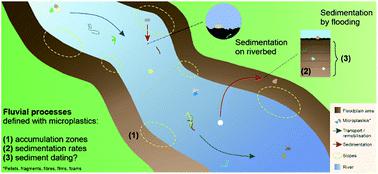当前位置:
X-MOL 学术
›
Environ. Sci.: Processes Impacts
›
论文详情
Our official English website, www.x-mol.net, welcomes your
feedback! (Note: you will need to create a separate account there.)
Why analysing microplastics in floodplains matters: application in a sedimentary context
Environmental Science: Processes & Impacts ( IF 4.3 ) Pub Date : 2020-11-27 , DOI: 10.1039/d0em00431f Simone Lechthaler 1, 2, 3, 4, 5 , Verena Esser 2, 4, 5, 6, 7 , Holger Schüttrumpf 1, 2, 3, 4 , Georg Stauch 2, 4, 5, 6, 7
Environmental Science: Processes & Impacts ( IF 4.3 ) Pub Date : 2020-11-27 , DOI: 10.1039/d0em00431f Simone Lechthaler 1, 2, 3, 4, 5 , Verena Esser 2, 4, 5, 6, 7 , Holger Schüttrumpf 1, 2, 3, 4 , Georg Stauch 2, 4, 5, 6, 7
Affiliation

|
Microplastics in the environment are a relatively new form of anthropogenic contamination. Right now, the research focus is on the detection of microplastic accumulation in different environmental compartments and understanding the processes that have led to its transport. Detailed information on microplastics in floodplain areas and their distribution in depth are still missing to better understand accumulation points. Therefore, this study presents on the one hand microplastic detection in fluvial sediments from nine sampling sites along a river course. Polymers were determined with infrared spectroscopy and additional sedimentary analysis of the grain size and heavy metal concentration was performed. In total, there was less microplastic in the upper than in the lower river course and slip-off slopes were identified as accumulation hotspots also in deeper sediment layers. Mostly, microplastic particles were detected in fine sediment and heavy metal concentrations along the river were similar to those of microplastics. On the other hand, besides the spatial distribution of microplastics and accumulation in floodplain areas, microplastic analysis offered information in a sedimentary context. Sedimentation rates (0.29–4.00 cm a−1) and patterns between temporal deposition and microplastic polymers were identified. The basis for the development of a dating method by detection of MPs in sediments was thus established. Microplastics as a contaminant provide, in addition to the identification of deposition areas, further data in a temporal and sedimentary perspective.
中文翻译:

为什么分析洪泛区中的微塑料很重要:在沉积环境中的应用
环境中的微塑料是一种较新的人为污染形式。目前,研究重点是检测不同环境隔室中的微塑料积聚,并了解导致其迁移的过程。为了更好地了解积聚点,仍缺少有关泛洪区微塑料及其深度分布的详细信息。因此,本研究一方面提出了沿河道的9个采样点的河流沉积物中的微塑性检测。用红外光谱法测定聚合物,并进行粒度和重金属浓度的附加沉积分析。总共,上部河道中的微量塑性比下部河道中的少,并且在更深的沉积层中,滑坡也被认为是堆积的热点。大多数情况下,在细小沉积物中检测到微塑料颗粒,沿河的重金属浓度与微塑料相似。另一方面,除了洪泛区中微塑料的空间分布和积累以外,微塑料分析还提供了沉积环境下的信息。沉积速率(0.29–4.00 cm a 微塑性分析提供了沉积环境中的信息。沉积速率(0.29–4.00 cm a 微塑性分析提供了沉积环境中的信息。沉积速率(0.29–4.00 cm a-1)以及在时间沉积和微塑性聚合物之间的模式得到了确认。因此,建立了通过检测沉积物中MPs来确定测年方法的基础。除了识别沉积区域外,微塑料作为污染物还提供了时间和沉积方面的进一步数据。
更新日期:2020-12-10
中文翻译:

为什么分析洪泛区中的微塑料很重要:在沉积环境中的应用
环境中的微塑料是一种较新的人为污染形式。目前,研究重点是检测不同环境隔室中的微塑料积聚,并了解导致其迁移的过程。为了更好地了解积聚点,仍缺少有关泛洪区微塑料及其深度分布的详细信息。因此,本研究一方面提出了沿河道的9个采样点的河流沉积物中的微塑性检测。用红外光谱法测定聚合物,并进行粒度和重金属浓度的附加沉积分析。总共,上部河道中的微量塑性比下部河道中的少,并且在更深的沉积层中,滑坡也被认为是堆积的热点。大多数情况下,在细小沉积物中检测到微塑料颗粒,沿河的重金属浓度与微塑料相似。另一方面,除了洪泛区中微塑料的空间分布和积累以外,微塑料分析还提供了沉积环境下的信息。沉积速率(0.29–4.00 cm a 微塑性分析提供了沉积环境中的信息。沉积速率(0.29–4.00 cm a 微塑性分析提供了沉积环境中的信息。沉积速率(0.29–4.00 cm a-1)以及在时间沉积和微塑性聚合物之间的模式得到了确认。因此,建立了通过检测沉积物中MPs来确定测年方法的基础。除了识别沉积区域外,微塑料作为污染物还提供了时间和沉积方面的进一步数据。











































 京公网安备 11010802027423号
京公网安备 11010802027423号